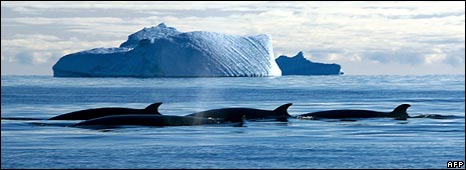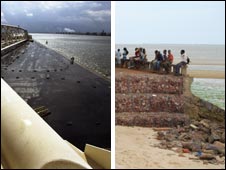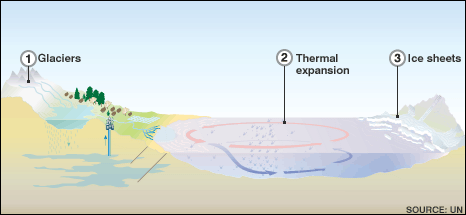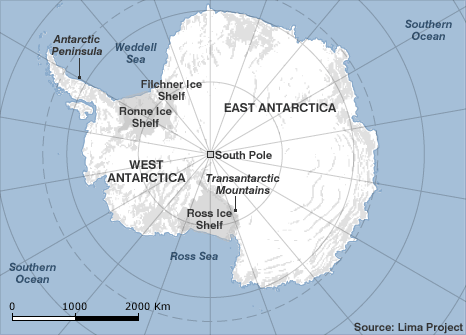 Major sea level rise likely as Antarctic ice melts
Sea levels are likely to rise by about 1.4m (4ft 6in) globally by 2100 as polar ice melts, according to a major review of climate change in Antarctica. Conducted by the Scientific Committee on Antarctic Research (SCAR), it says that warming seas are accelerating melting in the west of the continent. Ozone loss has cooled the region, it says, shielding it from global warming. Rising temperatures in the Antarctic Peninsula are making life suitable for invasive species on land and sea. The report - Antarctic Climate Change and the Environment - was written using contributions from 100 leading scientists in various disciplines, and reviewed by a further 200. "The temperature of the air is increasing, the temperature of the ocean is increasing, sea levels are rising - and the Sun appears to have very little influence on what we see," he said.
SCAR's report comes 50 years to the day after the Antarctic Treaty, the international agreement regulating use of the territory, was opened for signing, and a week before the opening of the potentially seminal UN climate summit in Copenhagen. High rise Two years ago, the Intergovernmental Panel on Climate Change (IPCC) projected that the global average sea level would probably rise by 28-43 cm (11-16in) by the end of the century. But it acknowledged this figure was almost certainly too low, because it was impossible to model "ice dynamics" - the acceleration in ice melting projected to occur as air and water temperatures rise. Launching the SCAR report in London, lead editor John Turner from the British Antarctic Survey (BAS) suggested that observations on the ground had changed that picture, especially in parts of the West Antarctic ice sheet. "Warmer water is getting under the edges of the West Antarctic ice sheet and accelerating the flow of ice into the ocean," he said.
By the end of the century, he said, the sheet will probably have lost enough ice alone to raise sea levels globally by "tens of centimetres". The remainder of the projected rise would come from melting of the Greenland cap, melting of mountain glaciers in the Himalayas and Andes, and the expansion of seawater as it warms. A number of research teams have come up with similar projections. But this is the first time that an international body such as SCAR has endorsed the likelihood that sea levels will rise enough to threaten some of the world's biggest cities by the end of the century. Cold store The Antarctic Peninsula - the strip of land that points towards the southern tip of South America - has warmed by about 3C over the last 50 years, the fastest rise seen anywhere in the southern hemisphere, according to the report. But the rest of the continent has remained largely immune from the global trend of rising temperatures.
Indeed, the continent's largest portion, East Antarctica, appears to have cooled, bringing a 10% increase in the sea ice extent since 1980. This report backs the theory that it has bucked the global trend largely because of ozone depletion - the chemical havoc wrought over 30 years by chlorofluorocarbons (CFCs) and other agents in the stratosphere above the polar region. "We used to have a big blanket of ozone, and when we took it away we saw a cooling," said Professor Turner. "The Antarctic has been shielded from the impacts of global warming." But, the report concludes, that will not last forever. The ozone hole is expected to repair itself in about 50 years, now that the Montreal Protocol has curbed the use of ozone-destroying substances. As it does so, the SCAR team predicts that greenhouse warming will come to dominate the temperature change across Antarctica, as in other parts of the planet. Doubling of greenhouse gas concentrations in the atmosphere would warm the continent by 3-4C, it says. The majority of Antarctica is so cold that a rise of this magnitude in air temperature would have little impact. But more warming of the oceans would speed ice loss still further, the report concludes. On the basis of declines seen around the Antarctic Peninsula, it would also be expected to bring significant reductions in the abundance of krill, a key foodstuff for baleen whales and other animals. |
Email this page to a friend
If you speak another language fluently and you liked this page, make
a contribution by translating
it! For additional translations check out FreeTranslation.com
(Voor vertaling van Engels tot Nederlands)
(For oversettelse fra Engelsk til Norsk)
(Для дополнительных
переводов проверяют
FreeTranslation.com )





